Apollo 13
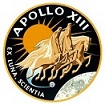
Day 3, part 4: Free Return
Corrected Transcript and Commentary Copyright ©2020 by W. David Woods, Johannes Kemppanen, Alexander Turhanov and Lennox J. Waugh. All rights reserved.
Last updated 2020-04-21
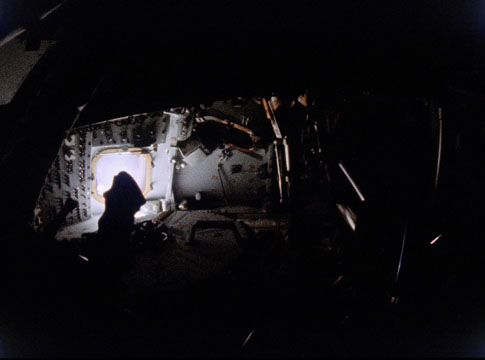
16mm film capture into the dark Command Module. Taken during the coast home.
059:36:25 Lousma: Aquarius, Houston. We'd like to have Aft Omni, and we're going to lose contact with you for about a minute here while we try to establish tracking. And our latest data shows that your closest approach to the Moon is going to be 60 miles perigee. Over.
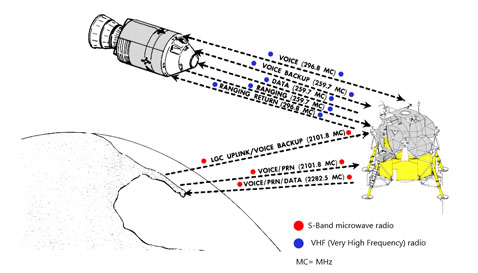
Diagram of the different communications frequencies being used. PRN refers to Pseudo Random Noise, which is used to determine the range to the spacecraft from the tracking station.
059:36:44 Haise: Okay. Closest approach, 60 miles, and I'm sitting on Aft Omni now.
059:36:50 Lousma: Roger. We'll probably be going off the air here in about a minute.
059:41:12 Lovell: Houston, Aquarius. Over.
059:41:14 Lousma: Go ahead, Aquarius.
059:41:19 Lovell: Okay. We're thinking about rigging up the urine dump to the side hatch. We're thinking about rigging up the urine dump to the side hatch and save urine heater power. What do you think?
059:41:36 Lousma: Stand by one.
059:41:42 Lovell: Better still so we won't freeze up our urine dump.
059:41:48 Lousma: Roger. That sounds like a good plan, Jim. Why don't you go ahead with that one?
059:42:59 Lousma: Okay, Aquarius. And down here we're getting regrouped, trying to work on your control modes and trying to set up something for PTC and taking a look at consumables as opposed to Flight Plan, and so forth, and as soon as we get all that information, we'll pass it up to you. We also have the 14 backup crew over in the simulators looking at dock burns and also trying to see what kind of alignment procedures they can come up with for looking at stars out the window. So if you ever are able to see any stars out there and think you can do an alignment out the window, why let us know.
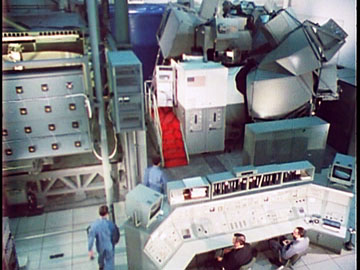
Lunar Module Simulator. The large console at the foreground was used to operate the simulator and the massive computer system running it. NASA 16mm film capture.
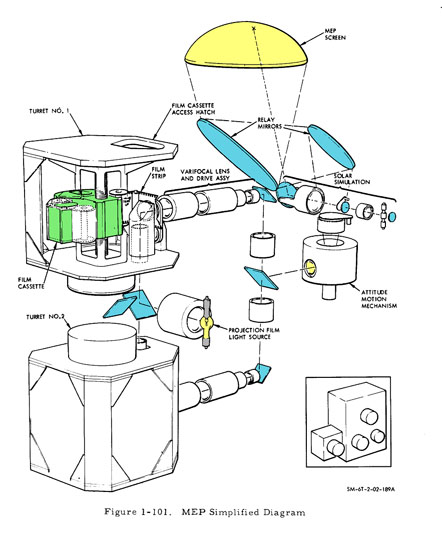
The MEP system was used to project simulated starscapes and planetary bodies to the LM simulator windows.
059:43:40 Lovell: Okay. Jack, right now we're not able to. The sunlight's reflecting off the thrusters and whatever debris came away at the time of the mishap is still with us, such that the stars are hard to find, and why - what respect do you want us to do the stars out the window - just to check the LMS run, is that correct?
059:44:04 Lousma: That's affirmative. We'd like to correlate the information we get with yours, so that if we can use it to update the platform, we can. [Pause.]
059:44:20 Lousma: What we're really trying to do, Jim, is see if we can do a COAS align so we can power down the platform. [Long pause.]
059:45:23 Haise: That is Aquarius. We're getting an awful lot of static on the uplink now, and we're not reading you at all. [Pause.]
059:45:39 Haise: I have good signal strength and I'm on Aft Omni.
059:45:51 Lousma: How do you read now, Aquarius?
059:47:06 Young: Hey, Jim, do you suppose that you could orient the LM so that the Service Module would be between you and the Sun? I believe you could see - recognize constellations out your front windows then. [Long pause.]
059:47:47 Lousma: Aquarius, Houston. Radio check. [Long pause.]
059:48:15 Lovell: Okay, Jack. How do you read now?
059:48:17 Lousma: Okay. Hearing you 5 square now, Jim. And the question we have, is there some way you can orient the spacecraft so that the Service Module is between the LM and the Sun so you can recognize constellations out the window? And secondly, can you see anything out the AOT? [Long pause.]
059:49:28 Lousma: Aquarius, Houston. How do you read?
This is Apollo Control; 59 hours, 51 minutes Ground Elapsed Time; continuing to stand by as we go through momentary loss of communication as the antennas and the spacecraft attitude drift past the point at which the ground tracking stations can receive from the spacecraft antennas. To back up and recap the earlier maneuver PAD, or information regarding Descent Propulsion System abort for minimum return time - this maneuver, should it be done, would come at 79 hours, 25 minutes, 26 seconds Ground Elapsed Time; at an altitude above the Moon of 205 nautical miles. The maneuver would be 1,797.7 feet per second posigrade; burn time of 8 minutes, 35 seconds; would produce entry interface at about 133 hours Ground Elapsed Time. Apollo 13 is now 185,455 nautical miles [343,463 km] out from Earth; velocity showing on the display here in Mission Control, 3,118 feet per second [950 m/s]. The spacecraft crew aboard Aquarius and Odyssey are now powering down, carefully husbanding all of the consumables aboard the spacecraft. We're continuing to stand by at 59 hours, 53 minutes Ground Elapsed Time; this is Apollo Control.
059:53:46 Lousma: Aquarius, how do you read me now?
059:56:56 Lousma: Aquarius, Houston. How do you read? [Pause.]
059:57:08 Lousma: Aquarius, request Forward Omni, please.
059:58:22 Lousma: Aquarius, Houston. Request Forward Omni. How do you read? [Long pause.]
059:59:06 Haise: Okay, Houston; Aquarius. How do you read?
059:59:09 Lousma: Hello there, Aquarius. Loud and clear. How do you read me?
059:59:14 Lovell: There's an awful lot of background...
059:59:16 Haise: We get a lot of background static, Jack. You're down in the mud. You having a ground problem?
059:59:23 Lousma: What we tried to do was to get the IU frequency shifted off a little bit so that we'd have less interference. I think it'll come up - What we want you to do is turn on your descent oxygen and turn off your ascent oxygen. Over. And request Forward Omni.
059:59:43 Haise: You're unreadable, Jack. We've got our signal strength meter - right now it keeps wavering up and down, and the best I'm getting is about 2.4 AGC.
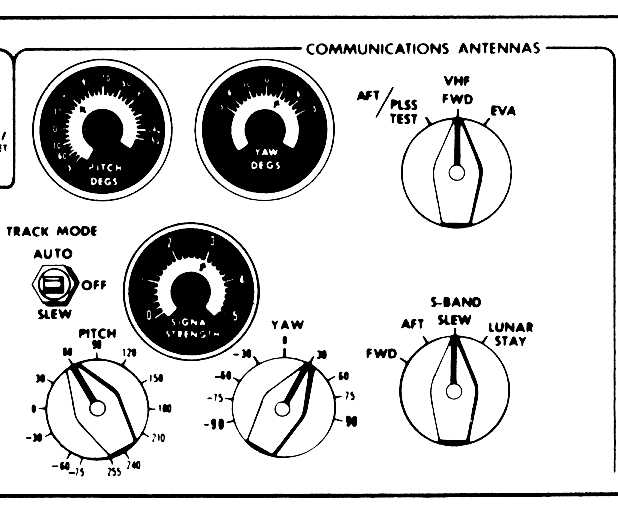
Communications panel in the LM. Scan via heroicrelics.org
059:59:53 Lousma: Roger. Request Forward Omni.
059:59:58 Haise: I am on Forward Omni. I've been on Forward Omni. [Long pause.]
060:00:43 Haise: Okay. How do you read, Jack?
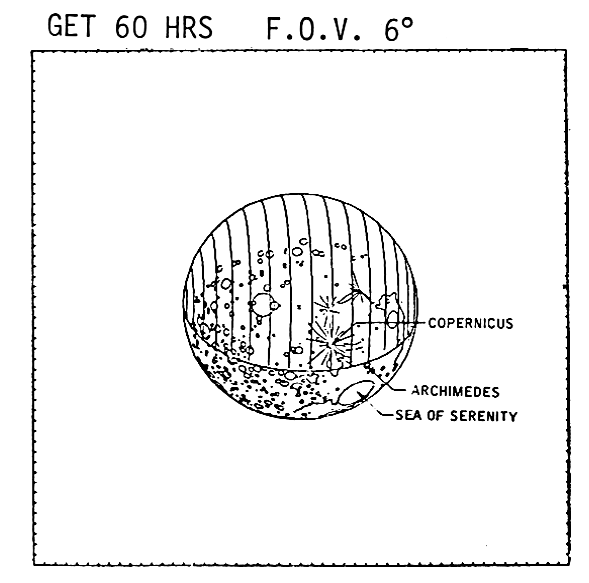
Computer-generated image of the Moon as it would be viewed from the Apollo spacecraft at 60 hours GET.
060:00:46 Lousma: I'm hearing you 5 square, Fred. How me? [Long pause.]
060:01:13 Lousma: Aquarius, Houston, How do you read. [Long pause.]
060:01:58 Haise: Okay. We're up to about 2.6 AGC now.
060:02:03 Lousma: Aquarius, Houston. Radio check. [Pause.]
060:02:10 Haise: Okay. Every time you Transmit, Jack, the AGC starts to drop off and the static level turns up.
060:02:18 Lousma: Okay, Fred. You're loud and clear.
060:02:24 Haise: I wish you were.
060:02:30 Lousma: Fred, go to Descent O
2.
060:02:35 Haise: Descent O
2. Roger.
060:04:05 Lovell: Hello, Houston; Aquarius.
060:04:08 Lousma: Hello there, Aquarius. How do you read me now? [Pause.]
060:04:23 Lovell: Hello, Houston. Aquarius.
060:04:26 Lousma: Aquarius, Houston. Go.
060:04:30 Lovell: Okay. That's the first clear word we heard from you, Jack. Do you think it could be my pitch attitude that's breaking up your incoming? I guess you've been hearing us.
060:04:42 Lousma: We have been hearing you, and the problem is on the ground. I hope we have it corrected now.
060:04:51 Lovell: Okay. That sounds good.
060:04:53 Lousma: We're considering powering down the PGNS but we want to know what capability you have to do a coarse and fine align. We read your conversation about being unable to see out the window very good. How about out the AOT? [Long pause.]
060:05:26 Haise: He's looking now.
060:05:29 Lousma: Okay. And the other thing we thought you might try is to put the Service Module between you and the Sun and then to see if you can see anything out the window in that attitude.
060:05:43 Young: The reason that we think that that would work is that it worked on Apollo 10. It made the constellations all recognizable when we put the the Service Module - in our case a LM, between us and the Sun.
060:06:00 Lousma: Aft Omni, Fred. [Pause.]
060:06:07 Haise: You're down in the mud again, Jack. It appears that some other circuit is feeding through on there with you.
060:06:14 Lousma: Roger. Aft Omni. [Long pause.]
060:06:42 Lousma: Aquarius, Aft Omni. [Long pause.]
This is Apollo Control. John Young sitting in at the Capcom console with Jack Lousma giving the benefit of his experience in Apollo 10.
060:07:29 Haise: Okay. You're down in the mud again, Jack. Lots of background static. [Long pause.]
060:08:10 Lousma: Aft Omni, Aquarius. [Long pause.]
060:09:00 Lousma: Aquarius, Houston.
060:11:18 Haise: Okay, Houston; Aquarius. How do you read?
060:18:21 Lousma: Aquarius, Houston. How do you read?
This is Apollo Control; 60 hours, 21 minutes Ground Elapsed Time. At the present time, the Flight Dynamics Officer here in Mission Control is computing a maneuver to place Apollo 13 back on a free return trajectory within the next hour. The maneuver would likely come at about 61 hours Ground Elapsed Time. The Lunar Module Primary Guidance and Navigation System, so-called 'pings', will be left powered up for the next hour, and then powered down to conserve water, which is used for cooling the electronics in the system. We'll stand by as this next maneuver is generated and passed up to the crew. Having some communications problem as the spacecraft drifts through the various Omni antenna look angles. The High Gain Antenna has not been powered up, to conserve the electrical power. At 60 hours, 22 minutes Ground Elapsed Time, standing by; this is Apollo Control.
060:22:46 Haise: Hello, Houston; Aquarius. How do you read?
060:22:48 Lousma: Hello, there, Aquarius. Loud and clear. How me, now?
060:22:54 Lovell: Okay, we're reading you loud and clear, Jack. I hope it stays this time.
060:22:58 Lousma: Okay. We'd like to brief you on what our plan is. We're, at this time, water critical in the LM. So we'd like to use as little as possible. To do this, we're going to plan to make a free return maneuver of 16 feet per second at 61 hours, which is 37 minutes from now. Then we're going to power down the PGNS, and then we'll - at 79 hours, we'll go ahead and make another abort maneuver to kick what we got. But we'd like to get that PGNS powered down as soon as possible. That would be after the midcourse and - so how do you feel about making a 16-foot-per-second burn in 37 minutes?
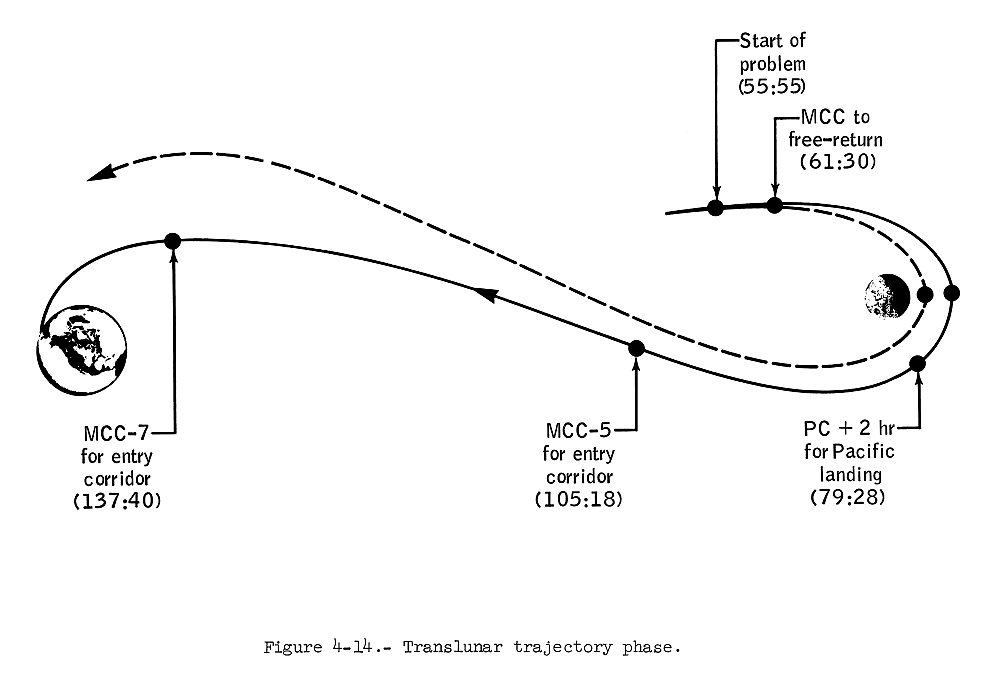
The trajectory of Apollo 13 after the explosion.
060:23:49 Lovell: Well, we'll give it a try, Jack, if that's all we've got. That's a 16-foot-per-second DPS burn in 37 minutes?
060:23:57 Lousma: Roger. We're working up a PAD for it, but we'd want to know what you think about doing it at that time.
060:24:08 Lovell: Well, we'll do it. Could you give us a little bit more time? [Long pause.]
060:24:30 Lousma: Okay, Jim. We'd like to get a suggested time from you. We can figure out a free-return maneuver for any time you want to give us, so if you'll give us the time you'd like to shoot for, we'll figure out a PAD.
060:24:47 Lovell: Okay, that sounds good. I think if we have a little bit more time; we want to do it right. Stand by one. [Pause.]
060:25:04 Lovell: Let's shoot for an hour if we can, Jack. How's that. [Pause.]
060:25:15 Lousma: Okay, Jim. How about 61 hours and 30 minutes? That's an hour and 5 from now.
060:25:24 Lovell: Okay. We'll do it and we want to be sure we talk back and forth now to make sure we get this burn off right.
060:25:31 Lousma: Affirm.
060:25:35 Haise: Okay, in the interim, Jack, I looked around again and I saw that we have a radar and a landing radar heater breaker in. Can I pull those out?
060:25:46 Lousma: Affirmative. Pull them both out.
060:25:52 Lousma: And now we want to ask you a question about alignments, and so forth. We wanted to know if you can see any stars out of the AOT. We also wanted to know if you could use the Service Module to cast a shadow on the LM windows and then look out the windows to see stars for a P51 COAS alignment.
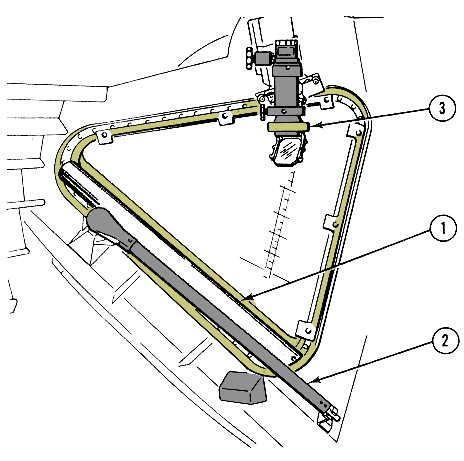
The COAS (No 3.) on its position at the Commander's window in the LM.
060:26:14 Lovell: Okay, in this attitude, Jack, that we're pitching around, I cannot use the AOT to see stars. We - we're just not able to see them at all. Now we may be able to maneuver off in yaw or - and/or roll and see stars. Right now, we haven't been able to. The AOT is useless. The Command Module structure is just radiating too much light into the - into the telescope.
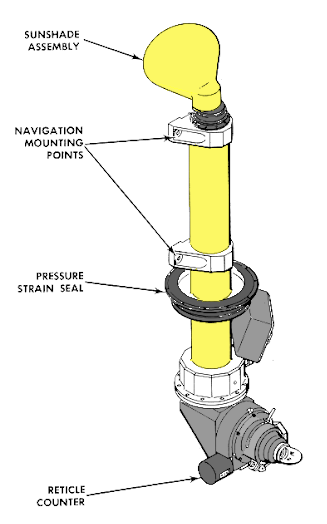
The AOT assembly.
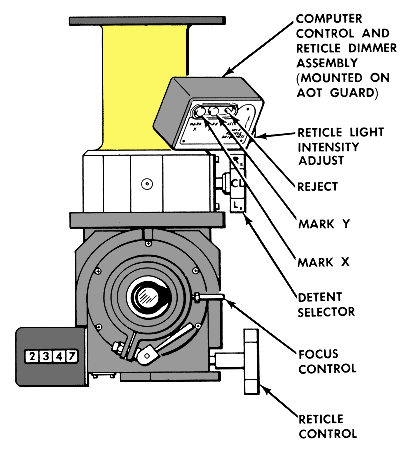
The AOT as viewed from the cabin. Diagram.
060:26:41 Lousma: Okay, and how about using the Service Module to cast a shadow on the commander's window? If you do that, can you see stars for a COAS alignment?
060:26:55 Lovell: We could give that a try, Jack, although I don't know how successful it will be. We tried to do it ... The light shines off our quads which makes it difficult to see stars. We do have the Earth and the Moon, if that can be of assistance.
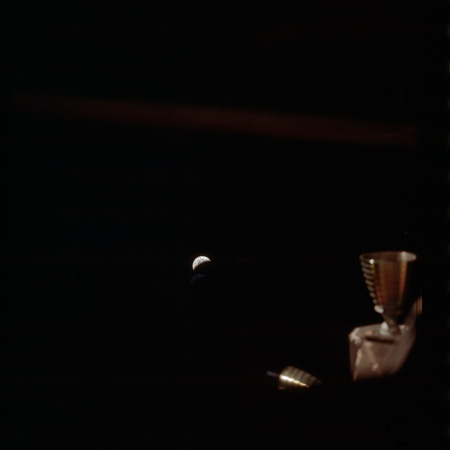
In-flight photo AS13-62-8954 showing the shiny RCS quad outside the window. Color correction by David Woods.
060:27:18 Haise: Another problem - Right now, Jack, I'm looking out the right window and it's pretty dark out that window but there are about a thousand or so false stars out here from - left over from some of the debris. It's hard to discern what's real and not real.
060:27:38 Lousma: Okay. That's good information and during the time that we see you're continuing to pitch, if you ever get in a position where you think the AOT might be of some use, we'd like you to periodically look out of it and see if you can see some stars that would enable us to get a P52.
060:27:59 Lovell: Okay, will do. And also, let me ask you a question. In this configuration, docked, we have to use the TTCA to control pitch and roll. And, just how much can we use that without really changing our trajectory? We only have 60 miles to play with.
060:28:21 Lousma: Roger, we'll put that to them. [Long pause.]
060:28:45 Haise: Okay, Jack, are you ready to go to work with me on the 2-hour DPS activation and contingency book, page 1?
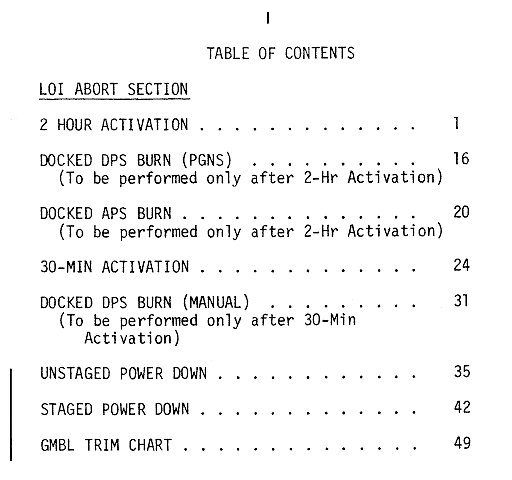
LM Contingency Checklist
060:28:54 Lousma: Roger, we're ready to go. [Pause.]
060:29:05 Haise: Okay. Item one, we can - one through five, we can scratch off, as done. Is that correct?
060:29:14 Lousma: Stand by one, Fred.
060:30:18 Lousma: Okay, Fred, let's go ahead. Step 1, page 1. Everybody's listening.
060:30:28 Haise: Okay, I've looked around, and I've essentially done steps 1 through 5 with the exception of floodlights and utility lights and I think we'll just do without those.
060:30:40 Lousma: Roger. Your choice. [Pause.]
060:30:47 Haise: Okay, on EPS activation, we're through step - we're through that - bottom of that page. That's all done.
060:30:58 Lousma: We concur, page 2. [Pause.]
060:31:13 Haise: Okay, in essence, we've circumvented step 4, and we're not sitting with all 4 amps - descent BATs on high-voltage taps, so I'll scratch off step 4.
060:31:28 Lousma: Roger, and in step 5, we want to leave Inverter 1 circuit breaker, Open.
060:31:37 Haise: Roger. In step 5, we'll leave Inverter 1 CB, Open.
060:31:41 Lousma: Omit step 6. [Pause.]
060:31:53 Haise: Okay, for the time being, our mission timer is the computer so, mission timer activation scratch off.
060:32:09 Haise: Okay. We've done the primary glycol loop activation.
060:32:15 Lousma: We verify it. [Pause.]
060:32:29 Lousma: Aquarius, we recommend you leave the caution and warning off on page 3.
060:32:37 Haise: Okay. I was going to say that next. Page 3, we'll just scratch item 1. And item 2, I've already got the RCS heaters on. And I don't know if I gave you the time or you got the time on the Primary Evap Flow number 1, Open.
060:33:04 Lousma: We got the time.
060:33:10 Haise: Okay. Let's go to the CB pages now. [Long pause.]
060:33:29 Lousma: Freddo, did you close the engine control breaker in panel 11?
060:33:38 Haise: What control is that, Jack?
060:33:40 Lousma: Did you close the S and C engine control breaker on panel 11? As we got step 1 there on page 3.
060:33:49 Haise: Okay. Okay, yes, the EPS Descent ECA Control breaker is Closed on 11. [Pause.]
060:34:00 Lousma: Roger, and how about the - on panel 11, S and C Engine Control, Closed? Aft Omni, Fred.
060:34:16 Haise: Okay. We're Aft Omni, and we have the S and C Engine Control breaker, Closed.
060:34:24 Lousma: Roger. Let's go on with the circuit breaker panel checkout.
060:34:34 Haise: Okay. I'll just give you - I think it'll be easier to give you what I got in. Okay, in the top row on 11, we have the four AC Bus Tie breakers, In, and the AC Bus Volts breaker, In, and that's it. Second row, we have the four TCA breakers, In. We have the GASTA under Flight Displays and Commander's FDAI. And likewise under AC Bus A, we have a GASTA and a Commander FDAI breaker, In. That's it. On row 3, we have a Signal Conditioner 1. We have the ATCA (PGNS). We have the Engine Control breaker, Attitude Direct Control breaker, and the - under Lighting, Anun/Dock/Component breaker, In. And one other; ED Logic Power A - ED Logic Power A is also In.
060:35:45 Haise: Okay, under the fourth - fourth row, we got all the Quad Heater breakers, In. Suit Fan 1. Under ECS, Glycol 1 and 2; and under Comm, we have Commander Audio, In, and PGNSs LGC/DSKY, IMU Standby, IMU Operate, and that's it. Okay, in the bottom row, EPS, we have the BAT Feed Tie both In, and we have the Cross Tie Balance Loads, In, the X Lunar Bus Tie, Descent ECA Control, Descent ECA, and the DC Bus Volts breaker.
060:36:38 Lousma: Roger. We copy. ...
060:36:39 Haise: That completes it for panel 11.
060:36:38 Lousma: Okay. Stand by.
060:36:38 Haise: Okay. [Long pause.]
060:36:54 Haise: As I see it, some of the short ones are - we need the DECA GIMBAL, In, sooner or later.
060:37:00 Lousma: That's affirmed. Close the DECA Gimbal.
060:37:01 Haise: And probably - Okay, DECA Gimbal, and sooner or later, we're going to need DECA Power, I guess, also.
060:37:15 Lousma: All right, DECA Power will come up later in the procedure, Freddo.
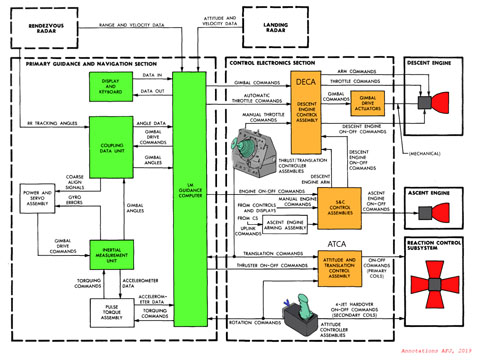
Guidance, Control and Navigation flow for the upcoming maneuver.
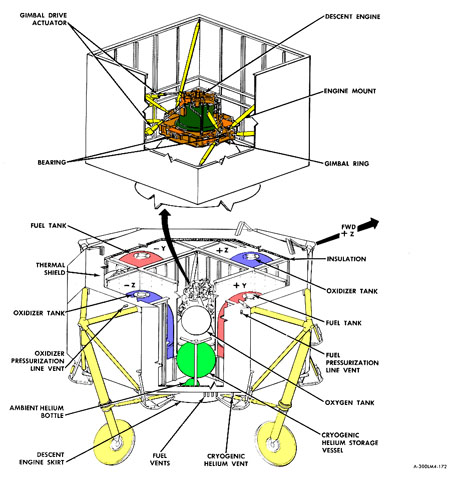
Structure of the Descent Stage, with the engine installation and the propellant and helium pressurization gas supply.
060:38:41 Lousma: Aquarius, Houston. On your circuit breaker checklist, on panel 11 and 16, we want you to configure the panels as outlined in the checklist.
060:38:57 Haise: Okay. You want us to configure as per checklist. Okay. We'll do that.
060:39:03 Lousma: That's right. Close the black ones and open the white ones.
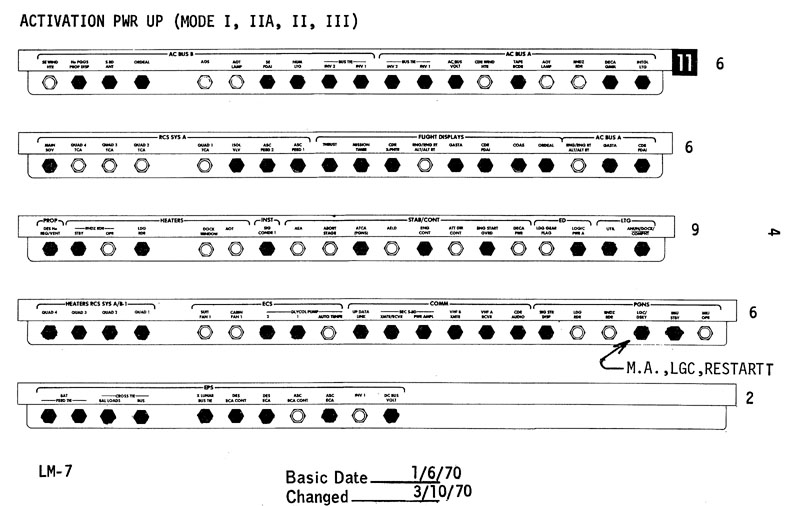
Circuit breaker configuration from the Contingency Activation Checklist.
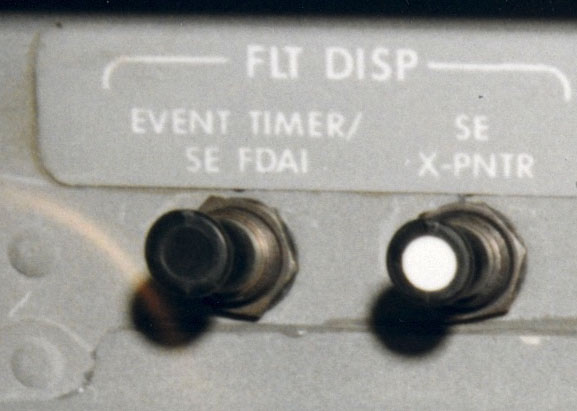
A closed and an open circuit breaker in the LM.
060:39:12 Haise: Yes. I think we can manage that.
060:39:19 Lovell: With the activation power up, we're starting right now. [Long pause.]
060:40:12 Lovell: Houston, we might as well leave our RCS TCAs, In, right? [Pause.]
060:40:23 Lousma: Affirmative, Jim. Leave your RCS TCAs in...
060:40:26 Haise: Check that...
060:40:27 Lousma: ...on panel 11.
060:40:30 Haise: ...Yes. I used my Pentel pen and made those white ones black ones.
060:40:35 Lousma: Roger. Same on 16, Fred.
060:40:46 Lovell: And you might look there, Houston, to see what circuit breakers aren't required, like the tape recorder.
060:40:52 Lousma: We're looking. [Long pause.]
060:41:41 Lousma: Okay, Jim. On panel 11 over there, you can also leave open the Rendezvous Radar Heater breaker and the Landing Radar Heater breaker, in addition to the tape recorder.
060:41:55 Lovell: They're out. [Pause.]
060:42:04 Lovell: I'm leaving a few in, Jack, too, like the Suit Fan 1 is still in, RCS System is still In, the TCAs. Attitude Direct Control is In.
060:42:18 Lousma: Roger. [Long pause.]
060:42:33 Lovell: How about if I leave the VHF A and B Off?
060:42:41 Haise: Switch to Forward Omni. [Pause.]
060:42:53 Lousma: Okay. We can leave the VHF powered down, too.
060:43:01 Lovell: And, do you want the Secondary S-Band?
060:43:04 Lousma: Negative on Secondary S-Band. Leave them open. [Pause.]
060:43:13 Lovell: Up Data Link is In. Do you want that in or out?
060:43:21 Lousma: Leave the Up Data Link open. We'll call for it when we want you to put it in.
This is Apollo Control; 60 hours, 44 minutes Ground Elapsed Time. Distance from Earth, 187,006 miles [346,335 km]; velocity, 3,089 feet per second [942 m/s]. Flight dynamics people still computing the midcourse correction to go back to a free return trajectory. Here in Mission Control the coffee cup has become a appliance second only to the headset in usefulness here.
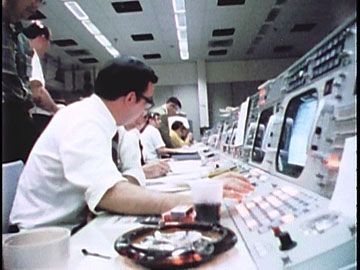
Photo into the Mission Control, with coffee, tobacco and cola-powered engineers at work.
060:44:36 Haise: Okay, Jack, on panel 11 on the top row, do you really want the Propulsion PQGS and Ascent Helium REGs in?
060:44:54 Haise: And, also the System Engineer X-Pointer breaker.
060:44:59 Lousma: Roger. Negative on the PQGS. Negative on the Ascent Helium Reg, and negative on the Crosspointer. [Pause.]
060:45:17 Haise: Okay. On the second row, I'm going to leave the Floodlight breaker open.
060:45:24 Lousma: Concur. [Pause.]
060:45:31 Haise: And we're again up to - Do you want the CWEA enabled?
060:45:39 Lousma: Negative on the CWEA.
060:45:44 Haise: Okay. [Long pause.]
060:46:02 Haise: Okay. Since we're - are we going to power up the AGS or should I concern myself with the ATCA breaker?
060:46:14 Lousma: Negative on the AGS. However, Fred, we need the ATCA breaker in.
060:46:28 Haise: Okay. ATCA breakers In. Yes. I guess for the backup power supply. Hey, how about ATCA AGS.
060:46:43 Lousma: Negative on ATCA AGS. [Long pause.]
060:47:05 Haise: And I'm leaving the Suit Flow Control breaker open. [Pause.]
060:47:20 Lousma: Let's close the Suit Flow Control breaker...
060:47:22 Lovell: And, now [Garbled]
060:47:23 Lousma: ...so it doesn't take any current.
060:47:30 Haise: Okay. Without suits, it doesn't do us much good either though. [Long pause.]
060:47:52 Haise: Okay. And are we going to continue to be able to operate off the Omnis, Jack. So can I leave the S-band antenna powered down? [Long pause.]
060:48:18 Lousma: Okay, Freddo. We don't plan to use the steerable antenna, although we want to leave the heaters on. So it looks you ought to open up Comm S-Band Antenna, but leave S-Band Antenna Heaters closed.
060:48:33 Haise: Roger. Comm S-Band is Open, S-Band Heater breaker is still Closed. [Long pause.]
060:49:26 Haise: And, on the bottom row, Jack, I'm going to leave the Heater Display breaker out, which we had pulled before, and EPS Display. But I question, do we want the Ascent ECA breaker in, as prescribed?
060:49:47 Lousma: Stand by. That's a negative on the Ascent ECA breaker. Leave it open. [Pause.]
060:50:02 Lousma: And, Aquarius, we need P00 and DATA...
060:50:04 Lovell: And that's...
060:50:05 Lousma: ...and we'll give you state vector and target load.
060:50:12 Haise: Okay. We need the Uplink breaker in then now.
060:50:17 Lousma: That's affirmative.
060:50:23 Lovell: Okay. And, Jack, will you give us that - how about the ORDEAL breaker? Can I pull that? We don't need that, do we?
060:50:32 Lousma: Negative on the ORDEAL. Leave it open. [Long pause.]
060:50:48 Haise: And how about the Ascent ECA breaker on panel 11? Jim has it in over there. [Pause.]
060:51:02 Lousma: And panel 11 Ascent ECA can be open.
060:51:07 Lovell: It's open. [Long pause.]
060:51:27 Lousma: Okay, Aquarius. We're Go on the circuit breaker configuration as you have it now.
060:51:36 Haise: Roger. [Long pause.]
060:52:04 Lousma: And, Aquarius, tests in the simulator just showed that if you want to let the PGNS DAP hold your attitude for you, it will.
060:52:16 Lovell: Okay, very well. [Long pause.]
060:52:30 Lovell: And, Jack, because it will take quite a while to get back to the attitude, I think we ought to think about going there very shortly.
060:52:37 Lousma: Roger. I have a PAD for you. I have a P30 maneuver PAD.
060:52:48 Lovell: Roger. Stand by.
060:52:53 Lovell: [Garbled]...
060:52:54 Haise: Go right ahead, Jack.
060:52:58 Lousma: Okay. We want you to hold your maneuver until we finish making the load. We haven't completed it yet. Are you ready to copy P30 maneuver PAD?
060:53:07 Haise: That's affirm.
060:53:09 Lousma: Okay. Here we go. The purpose is midcourse correction for free return. Noun 33: 061:29:42.84; minus 0021.3, plus 0004.1, minus 0031.2; H
A and H
P are N/A; Delta-V, 0038.0; 031, 120, 298, minus 00213, plus 00041, minus 00312; COAS, NA. And I have your LM GDA angles. Pitch 5.86, roll 6.75. Your DPS throttling, 5 seconds at 10 percent, burn the rest at 40 percent. Your ullage will be two jets for 10 seconds. [Long pause.]
060:54:57 Haise: Okay, Jack, we have a P30 maneuver PAD, a midcourse for free return. Noun 33: 061:29:42.84; minus 0021.3, plus 004.1, minus 0031.2; H
A and H
P, N/A; Delta-V
R, 0038.0; 031, 120, 298; minus 00213, plus 00041, minus 00312. COAS, N/A; GDA angles; pitch 5.86, roll 6.75; DPS throttle, 5 seconds at 10 percent; burn the rest at 40 percent. And we need a two-jet, 10-second ullage.
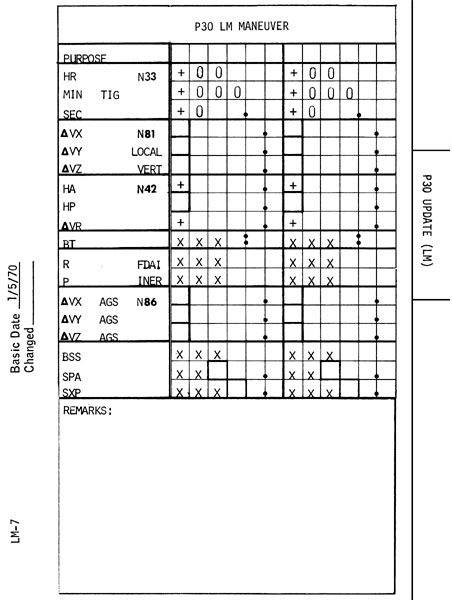
Example of a preprinted P30 External Delta-V Maneuver PAD sheet from the LM G&C Dictionary.
060:56:02 Lousma: That's a good readback, Fred. I'd like to verify, however, in Noun 81, in V
Y, it's plus three balls 41.
060:56:14 Haise: Okay. Noun 81, V
Y is plus 0004.1.
060:56:21 Lousma: Good readback. Let's press on with the checklist.
060:56:27 Lovell: Okay. And, Jack, find out about using TTCA to maneuver with.
060:56:32 Lousma: Okay. We're finished with the computer, it's yours, and we recommend using the TTCA to maneuver with.
060:56:43 Haise: Okay, I'm back on the checklist, page 6. Jack, under PGNS turn-on and self-test. We've done everything except the self test here on this page. Do you want to do that at this time? [Long pause.]
060:57:28 Lousma: Okay. Aquarius, negative on the PGNS self test. Page 7.
060:57:37 Haise: Okay. I'll scratch page 6 and on page 7, we're not going to activate the - or rather we had the S-band activated, ECS Activation I have all done. And, at the bottom of the page, the docked IMU coarse align is done.[Pause.]
060:58:03 Lousma: Roger. [Pause.]
060:58:14 Haise: We've - Okay, we've also completed, I guess in essence, all of page 8.
060:58:22 Lousma: That's affirmative and page 9 to boot. Scratch VHF. We've done the T
ephems. [Pause.]
060:58:36 Haise: Okay. You've updated it, that's right. We cranked in the time. [Pause.]
060:58:52 Lovell: And, Houston, let's go to activation - or get into page 10 and see what we did there.
060:58:58 Lousma: Okay. The only item on page 10 is to deploy the landing gear.
060:59:06 Lovell: Okay, we'll do that now.
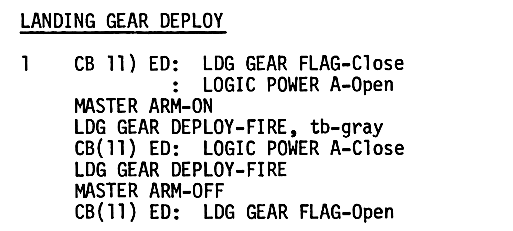
Landing gear deployment procedure.
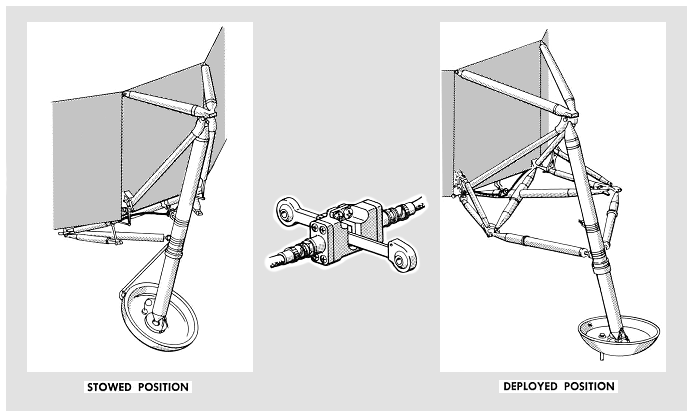
Diagram of the stowed and deployed positions of the landing gear.
061:00:10 Haise: Okay. The landing gear are down and locked, Jack, and looking ahead now at page 11, we've done all of that.
061:00:24 Lousma: We verify that. Page 12.
061:00:31 Haise: Okay, and I assume in amongst all those numbers you pumped up, we got a REFSMMAT and State Vector. Is that correct?
061:00:39 Lousma: That's affirmative. You've got that. So you can delete page 12.
061:00:47 Ground technician: Go Flight. Roger. It's got it.
061:00:52 Haise: Hey, on 13, you've read us up the fine align angles and we've cranked those in.
061:01:01 Lousma: Affirmative. [Pause.]
061:01:08 Haise: Okay, so now we're up to - we've got to do DAP set, the gimbal/throttle test.
061:01:13 Lousma: That's - Okay, Aquarius. We recommend omitting the DAP set, gimbal/throttle test - just make sure the gim - DECA Power and DECA Gimbal circuit breakers are closed.
061:01:33 Haise: Okay, we're going to proceed now with the DAP set, gimbal/throttle test, is that correct? Or did you say delete it?
061:01:40 Lousma: Aquarius, delete the DAP set, gimbal/throttle test. Just ensure that the DECA Power and the DECA GIMBAL are closed.
061:01:49 Lovell: Okay. Houston, DECA Power is Open at this time. Do you want me to close it?
061:01:54 Lousma: Affirmative, Jim. Close the DECA Power.
061:02:00 Lovell: It's Closed. We deleted that. [Long pause.]
061:02:27 Haise: Okay. Also out of that list, Jack, we need the Commander's Throttle set to Throttle and Min. [Long pause.]
061:02:58 Haise: Houston, if I recall the launch set of the gimbals, the GDAs are not correct here, and where are we going to get those set for the burn?
061:03:14 Lousma: Stand by one. [Long pause.]
061:03:33 Lousma: Okay. Here's the word on the DAP set, gimbal/throttle test. Let's do step 1 and step 2, and that'll get our gimbal set.
061:03:50 Haise: Roger. [Long pause.]
061:04:20 Haise: Okay, Jack, we're going to have to back up on this, if we're going to follow the procedure here, which has us go Mode Control; PGNS, Auto, we're going to have to pull the TCA breakers to keep from firing jets. [Long pause.]
061:04:53 Lousma: Stand by, Fred. [Long pause.]
061:05:28 Lousma: Stand by on step 1, Fred. We're getting the word for you. How do you like this SIM? [Pause.]
061:05:42 Haise: It's a beauty. [Long pause.]
061:06:09 Lousma: Okay, Aquarius, we recommend you do the DAP set and gimbal/throttle test as per the checklist. Go PGNS Auto and proceed.
061:06:21 Lovell: Well, we're going to fire our thrusters as soon as we go to Auto because we've got those thrusters in - the thruster circuit breakers. Do you want us to do that and stop? [Long pause.]
061:06:50 Lousma: Okay, Aquarius, we're recommending you go to Auto. Let the thrusters fire and settle down and proceed with the test. [Pause.]
061:07:06 Lovell: We're in PGNS Auto.
061:07:09 Lousma: Roger, your DAP is set, you're in wide dead band. That ought to do the trick.
061:07:19 Lousma: Okay, we're looking at it, Aquarius. We're ready to proceed with the test.
061:07:26 Haise: Okay, we're proceeding. [Long pause.]
061:07:52 Haise: Okay, and Houston, you - you're looking at the weights now. Those are still good, right?
061:08:01 Lousma: You're Go on the weights.
061:09:05 Lousma: Aquarius, Houston. We'd like you to recycle on the DAP load and change your DAP to 32021. Over.
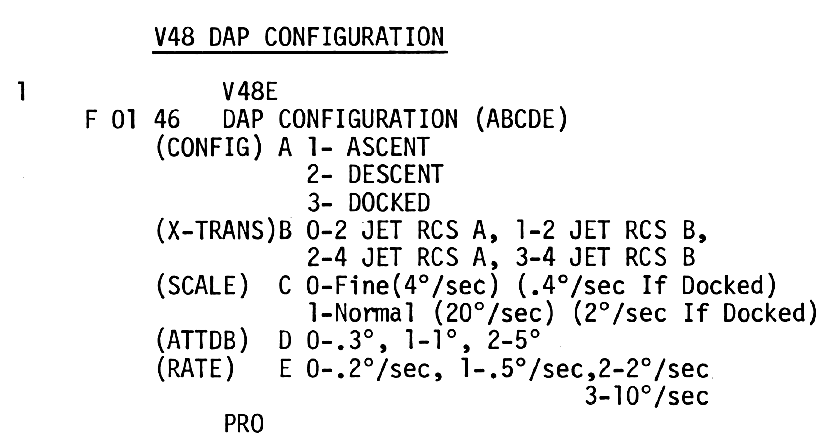
DAP configuration procedure
This is Apollo Control. We've got an ignition countdown clock running here now in Control Center showing 19 minutes, 19 seconds to ignition on the midcourse correction which will place Apollo 13 back on a free return trajectory. To recap the details of this maneuver, the ignition time would be at 61 hours, 29 minutes, 42 seconds Ground Elapsed Time. The velocity change would be 38 feet per second (11.6 m/s). Burn time, 30.7 seconds.
061:11:05 Lousma: Okay, Aquarius. We're looking at your gimbal and we notice that we got a four-jet ullage loaded in the DAP and we gave you two jets on the PAD. But, let's go with what we've got loaded. It'll be a four-jet ullage.
061:11:18 Haise: Okay. [Long pause.]
During this maneuver using the Descent Propulsion System, the throttle will be at 10 percent for the first 5 seconds of the burn and throttle up for the balance of the burn at 40 percent.
061:11:40 Haise: Okay, Houston. How does the GDAs look now?
061:11:45 Lousma: The GDAs are Go as they are. Press on. [Long pause.]
061:12:09 Lovell: Okay, Houston, we're going to do the DPS pressurization and checkout.
061:12:16 Lousma: Stand by one. [Long pause.]
061:12:34 Lousma: Okay, your gimbals are within 0.3 and we're ready for the DPS pressurization and checkout. [Long pause.]
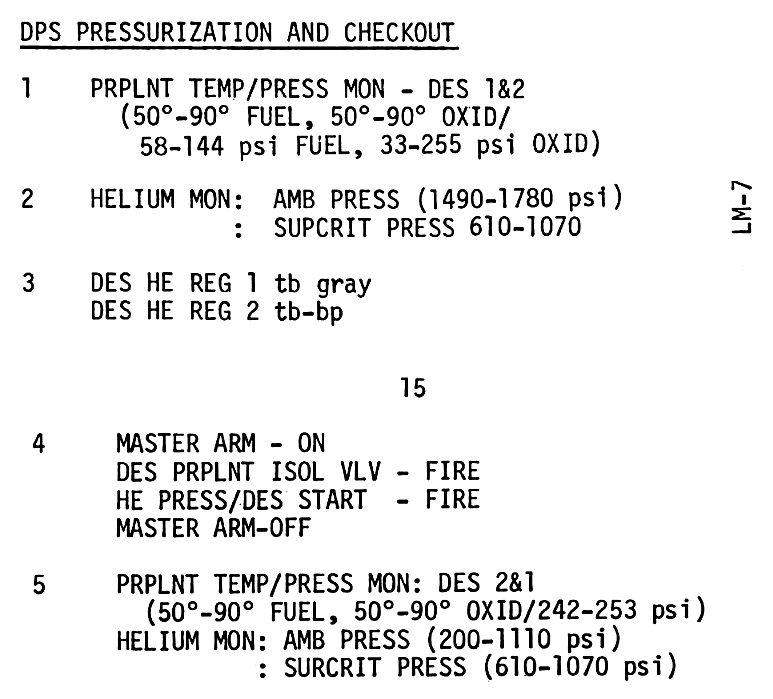
DPS pressurization from the LM 2-hour Contingency Checklist, pages 14 and 15
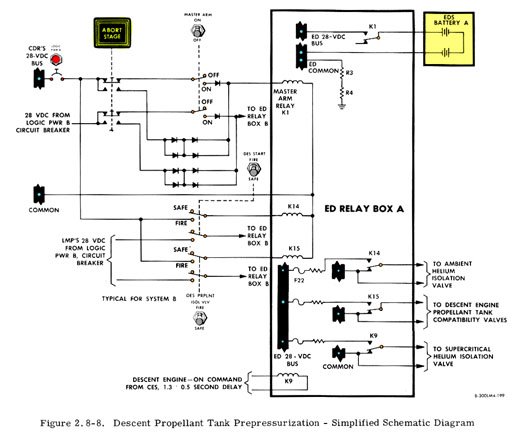
To pressurize the DPS, they must select Master Arm to enable the pyrotechnics and then turn the associated switches. Pyrotechnic isolation valves are used to open the piping that will transport the propellant, the oxidizer, and the helium used to pressurize the system. This way, all three will remain contained until they are required to be used, and are hence protected against the hardships of the launch and the translunar coast.
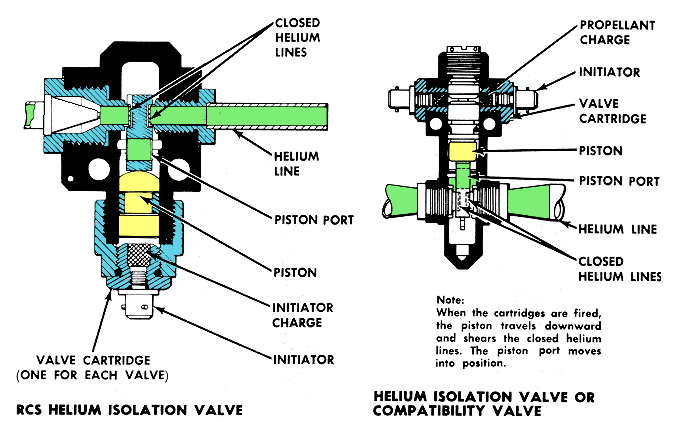
Applying power to the pyrotechnic device sends an electric charge to the detonator. The small explosive device createst a burst of mechanical energy which is used to drive a piston through the closed off propellant and helium lines. It shears the closure and puts the piston port into place, which allows the liquids and gasses to pass through into the system.
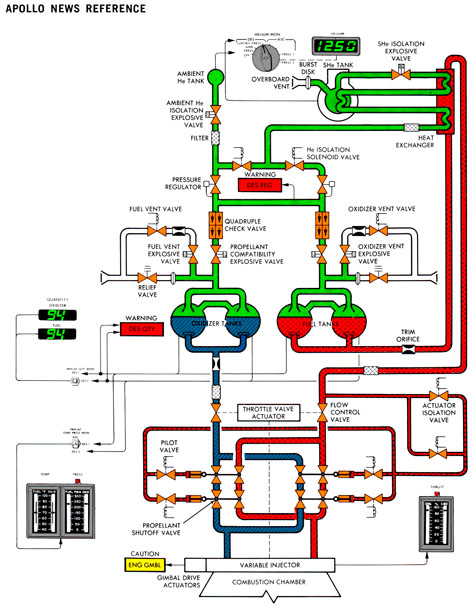
Functional flow diagram of the Descent Propulsion System. Colored from the LM News Reference. Green signifies the helium system.
061:13:33 Haise: Okay, Houston, do you want to follow up on page 15 with RCS checkout? In essence, we've kind of already done that.
061:13:47 Lousma: You're right, Aquarius. Let's delete the RCS checkout. And a DPS looks Go.
061:15:43 Lovell: Houston, we're going to do a PGNS Auto maneuver to the attitude.
061:15:49 Lousma: Stand by on that. Aquarius, we recommend driving it around there manually with a TTCA.
061:15:58 Lovell: Okay, we'll have to use the TTCA. Roger.
061:21:10 Lovell: We're going to Auto now, Houston, to try to damp the rates. We're at the attitude. [Pause.]
061:21:22 Lousma: Roger, Jim. We verify the attitude.
061:23:37 Haise: And, Houston, we'd like to confirm, do you want the Verb 65 Enter in there?
061:23:45 Lousma: Affirmative on the Verb 65.
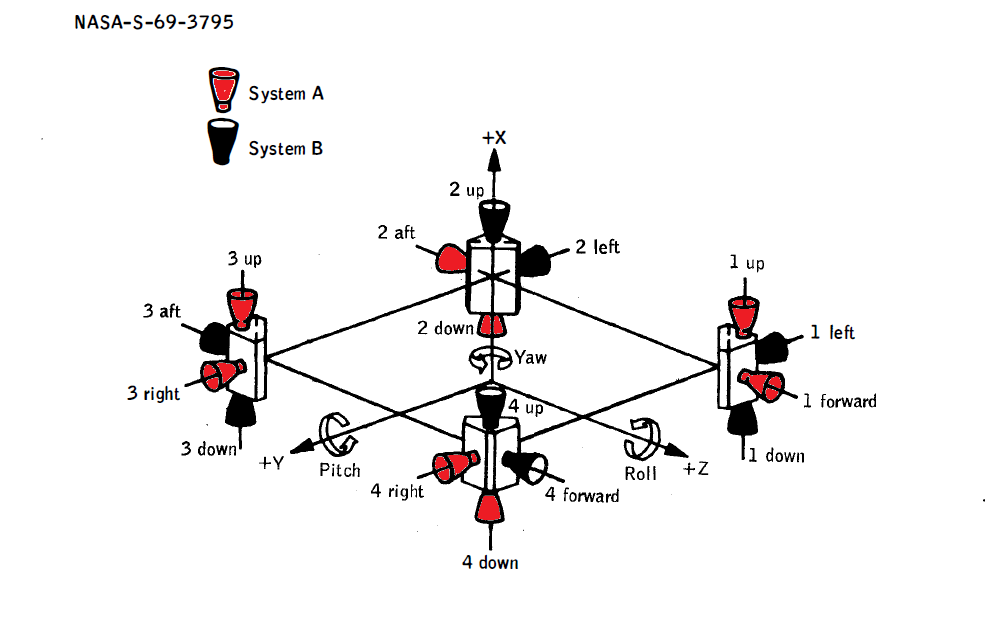
LM RCS geometry.
061:23:49 Haise: Okay. [Long pause.]
061:24:12 Haise: Okay, Jack. I got another question on page 18. At 1 minute, I concur with Master Arm, On, but I wonder why I have to have the Abort Stage breaker in. We sure don't want any staging now. [Pause.]
061:24:38 Lousma: Aquarius, delete the Abort Stage circuit breaker Close. Leave it open.
061:24:46 Haise: Roger. Will delete. [Pause.]
061:24:55 Haise: Okay. Also, Jack, since we have four-jet ullage versus two, do you want - still want 10 seconds ullage or do you want 5 now? [Pause.]
061:25:09 Lousma: Okay, Aquarius, we'll use automatic ullage. [Pause.]
061:25:18 Haise: Okay. We'll just let the 7½-second Auto ullage do it.
061:25:23 Lousma: Roger, and we'd like to do this in manual throttle, so on page 17 about two-thirds of the way down, Throttle Control, Manual, vice Auto.
061:25:35 Haise: Okay. We're set to Manual. [Long pause.]
061:25:58 Lovell: What's the 203 [Garbled]?
061:26:05 Lousma: Enter on the 203, Jim.
061:26:11 Lovell: We've got 203 in the DSKY now and it looks as though it requires work, can we pass it?
061:26:16 Lousma: Aquarius, Enter on the 203.
061:26:22 Lovell: Wait a minute. [Long pause.]
061:26:51 Lousma: Aquarius, we'd like to verify that your throttle is in the Min position.
061:26:58 Lovell: That's affirm.
061:27:00 Lousma: And, in the event that you have to do a manual takeover, turn the Engine Gimbal Off, Mode Control to Attitude Hold, and use the hand - use the TTCA.
061:27:16 Lovell: Roger. [Long pause.]
061:28:14 Haise: Okay, 1 plus 30 to burn.
061:28:20 Lousma: Roger. [Long pause.]
061:28:45 Haise: Okay, Master Arm's On; 1 minute.
061:28:53 Lousma: Roger, Aquarius. You're Go for the burn. [Long pause.]
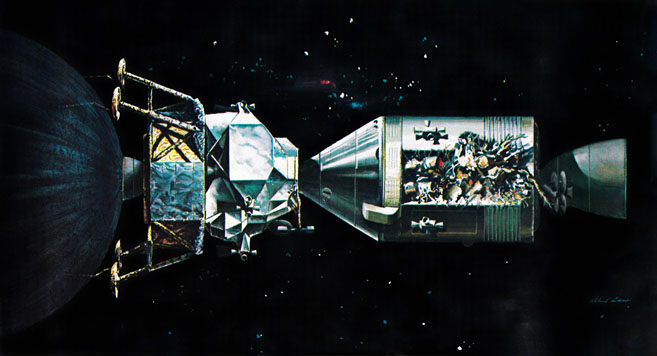
Contemporary illustration of the Lunar Module's Descent Engine burning to push the injured Odyssey onto the return trajectory.
061:29:55 Lovell: 40 percent. [Pause.]
061:30:04 Lousma: Okay, Aquarius. You're looking good. [Long pause.]
061:30:25 Lovell: Auto shutdown. [Long pause.]
061:30:40 Haise: Okay. You're looking at 16 85 now, Jack.
061:30:46 Lousma: Okay. You're Go in the residuals, proceed.
061:30:55 Haise: Okay. When you say Go on the residuals, you mean don't trim them. Is that right?
061:31:00 Lousma: That's affirmative. No trim required.
061:32:17 Lousma: Aquarius, check your Master Arm, Off, please. [Long pause.]
061:32:44 Lovell: Okay, Houston. Burn's complete. Now we have to talk about power-down, and what do you want us to do with the PGNS?
061:32:52 Lousma: Roger. We're looking at that right now, and you'll be the first one to get the word. [Long pause.]
061:33:19 Lovell: And, Houston, it's doubtful right now whether we'll be able to see the stars in this configuration. The only way we could possibly get alignment is with the Earth and the terminator or the Moon and its terminator and I'd sure like to have you look at a power-down - keeping the PGNS if at all possible. [Pause.]
061:33:49 Lousma: Roger, Jim. We'll get the word for you.
061:35:24 Lovell: And, Houston, we're in an Att Hold mode, can we turn off the buses? [Pause.]
061:35:40 Lousma: Stand by on that one, Jim.
061:38:13 Lousma: Okay, Aquarius. We're working on what's going to happen next. In the meantime, we'd like to take some high-power items off the line, so on panel 11, open DECA Power, and open DECA Gimbal. On 16, open the ATCA breaker. [Pause.]
061:38:36 Haise: Okay, on 11, we got DECA Power, DECA Gimbal, Open. On 16, we got the ATCA breaker Open. [Long pause.]
061:39:37 Lovell: And, Houston, while you're thinking, see if you can come up with a procedure of perhaps using the Command Module optics with manual drive to perhaps look for stars.
061:41:24 Lovell: And, Jack, Aquarius. While you're thinking - before we had our comm problems, we were wanting to know what to - whether we should hook up the side hatch urine dump system. So we wouldn't freeze up the normal urine dump system.
061:41:45 Lousma: Roger. We gave you a Go on that earlier. Sorry, you must have missed it. Use the side hatch for urine dump.
061:41:56 Lousma: And, how are the stars out the window now? [Long pause.]
061:42:13 Lovell: Well, I'll look again, Jack, but at this attitude, the Sun is reflecting off of - off of quad 4 so bright that it's ruining any night vision and we still got particles floating around us; I'll have to take a long look and see if I can see any star patterns.
061:42:34 Lousma: Roger. [Pause.]
061:42:44 Lousma: And Aquarius, we're going to have to hand you over to a different site now, and we think maybe things will work better if this time we turn off the S-band Transmitter/receiver, and bring it back up in 5 minutes. You copy?
061:42:59 Lovell: Okay. Stand by one. [Pause.]
061:43:10 Lovell: Okay. I understand you want us to turn off the S-band Transmitter/receiver and bring it up in 5 minutes. Is that correct?
061:43:15 Lousma: That's affirmative.
061:43:20 Lovell: Tell us when. [Long pause.]
061:43:42 Lovell: And you want us to maintain attitude control.
061:43:46 Lousma: Affirmative on the attitude control.
061:43:48 Lovell: That's auto attitude control. Okay. You maintain auto attitude control. [Pause.]
061:43:56 Haise: Okay, Jack, I'm back on the line now. On the S-band, you want me to turn off the Transmitter/ receiver and the power amps are off for 5 minutes. Is that - when you give me the word - is that what you want?
061:44:10 Lousma: Aquarius, leave the power amplifier the way it is. Turn the Transmitter/Receiver off for 5 minutes. Now.
061:44:19 Haise: Okay. You tell me - you tell me when.
061:44:22 Lousma: Okay. Turn it off now. See you in 5 minutes.

Communications controls at the console. Scan via heroicrelics.org
061:44:26 Haise: Okay. It's gone off. It's gone off for 5 minutes.
This is Apollo Control at 61 hours, 45 minutes Ground Elapsed Time. The process of handing over from the Goldstone station to the Honeysuckle station in Australia. There will be a gap of about 5 minutes while this handover is taking place. Meanwhile the people here in Mission Control Center are looking at ways of setting up some sort of scheme for passing thermal control or Bar-B-Que mode of thermal balance for the spacecraft, during the remainder of the coasting flight using the abort guidance system of the Lunar Module to provide the attitude control to set up this slow roll. Apollo 13 now 188,863 nautical miles [349,774 km] out from Earth; velocity, 3,084 feet per second [940 m/s]. At 61 hours, 46 minutes Ground Elapsed Time and standing by, this is Apollo Control.
061:52:44 Lousma: Aquarius, Houston. How do you read?
061:52:52 Haise: Okay. You're loud and clear there, Jack.
061:52:54 Lousma: Roger. Same here. We're - We're still discussing the next move.
061:53:04 Haise: I figured it. Let's just make it a good one. [Pause.]
061:53:18 Lousma: We're looking real close at water usage profiles, and right now things are kind of swinging toward leaving the IMU powered up and powering down the LGC, but we'll have more word for you shortly. And we recommend for sleeping that you leave one guy on watch. We recommend you don't make any urine dumps if you can help it, because it'll make the debris problem worse than it is now. And we have some items that you might want to transfer to the LM, some towels, some penlights, fecal bags, UTS. And do you have any more items that we can help you out with at the moment?
061:54:17 Haise: Okay. Stand by on your latter list there, Jack. I understand no urine dumps. I guess we'll work through the UCD and all the bags we got; and real quick there, can you give a DAP load that we want in here now to conserve the RCS. [Long pause.]
061:55:21 Lousma: Okay. For attitude control coordinates, we're recommending manual control Verb 76 and watch your middle gimbal angle. Your DAP load that you have now looks good.
061:55:37 Haise: Okay. It's Att Hold Verb 76 for the guy on watch. And the DAP load we got right now is okay.
061:58:17 Lousma: Aquarius, our decision for the time is to leave the IMU powered up, power down the LGC, and power down other nonessential items. We'll be coming up with a more precise checklist as soon as we can get it. Over.
061:58:36 Haise: Okay. The decision is to keep the platform, power down the computer, and we'll be standing by for further word on the powerdown, Jack.
061:58:47 Lousma: Roger. [Long pause.]
061:59:33 Lousma: And, Aquarius, for your information, we now have 136-[nautical-]mile [252-km] perigee. Confirmed by Doppler.
061:59:47 Haise: Okay. 136-mile perigee now. That's very nice. [Long pause.]
062:00:09 Haise: Oh, wait a minute, Jack. Did you say pericynthion or perigee?
062:00:13 Lousma: I meant pericynthion.
062:00:18 Haise: Ah. That's better.
062:05:19 Lovell: And, Houston, we pulled out your Updata Link circuit breaker, so if you want to update it for anything, let us know and we'll put it back in.
062:05:27 Lousma: Roger, Jim. We will.
062:09:41 Lousma: Aquarius, Aft Omni, please.
062:09:47 Lovell: Aft Omni.
062:14:26 Haise: Houston, do you read Apollo 13?
062:14:30 Lousma: This is Houston. Go ahead. Reading you weakly.
062:14:36 Lovell: Okay, Jack. We don't want to bug you, but you ought to be thinking - or what your thoughts are concerning what the next burn will be. I got to figure out a watch schedule and the sleep schedule and just how we can meet the next maneuver.
062:14:55 Lousma: Roger. We're getting you a Flight Plan update. We're still computing on your next burn, and we're getting ready to give you a procedure for power-down.
062:16:34 Lousma: Aquarius, one idea on managing the Omni antennas. It might make it easier on everybody if we disabled the Uplink Squelch and managed the antennas by switching when we hear the noise. Over.
062:16:58 Lovell: Roger. Will do.
This is Apollo Control; 62 hours, 24 minutes Ground Elapsed Time. Under discussion here in the control room are the various means by which the spacecraft thermal balance can be maintained through the night with a minimum amount of propellant and electrical usage. One man will be on watch in the crew throughout the night and they're looking at the possibility of manual control attitude to arrive at some sort of passive thermal control mode. Apollo 13 now 190,026 nautical miles [351,928 km] out; velocity, 3,064 feet per second [934 m/s]. At 62 hours, 25 minutes Ground Elapsed Time; this is Apollo Control.
062:26:07 Lousma: Okay, Aquarius. Here's what we're going to do. We'd like you to point the LM X-axis either north or south. That's the positive X-axis. It appears to us that it would be closer to orient the LM plus X-axis toward the south. Do that with the LGC powered up using the TTCA. After that, we propose to power down the LGC to save some power. However, this means that we lose the use of the TTCA, and we'll have to control the spacecraft with the hand controller in the Direct mode. Request your - your position on these two items. [Long pause.]
062:27:34 Lousma: Aquarius, Houston. How do you read? [Pause.]
062:27:45 Lovell: Okay, Jack. Understand. You want us to point the LM X - plus X-axis to the south using the TTCAs with the LGC powered up. Then, by powering down the LGC, we'll lose a TTCA. I wasn't too successful in controlling the spacecraft in attitude only, but I might be able to keep it out of gimbal lock.
062:28:14 Lousma: That's affirmative, Jim. We'd keep your ball powered up and go to Direct on the hand controller. And maintain attitude in a Direct position. [Pause.]
062:28:39 Lovell: Okay. Understand; and do you want some sort of a PTC mode, Jack?
062:28:47 Lousma: Affirmative. We'll take whatever PTC mode you can set up, Jim.
062:28:54 Lovell: Okay. And since you know our approximate attitude, how about just getting me something to find you on the DSKY for a southerly plus X-direction.
062:29:04 Lousma: Roger. Stand by one.
062:30:35 Lovell: And one other question, Houston. When you say power down the DSKY or the LGC, do you mean going into 06 or multiple circuit breaker?
062:30:48 Lousma: Stand by on powering down the DSKY, Jim. We'll give you the procedure for that. The procedure that we...
062:30:58 Lousma: ...the procedure that we have is listed in several places. It's in the Contingency checklist under 'Power down' on page 1, second paragraph. [Pause.]
062:31:21 Lousma: And we'll give you that word when we want you to do that. That's LGC only, not to power down the IMU. But we'd like to have you hold off on that until we send you the word. Over.
062:31:38 Lovell: Understand.
062:33:57 Lousma: And, Aquarius, while we're working on this, we have a proposed Flight Plan update for your working and resting cycles. And - You ready to copy? [Pause.]
062:34:14 Haise: Okay. Do you want me to write this in the Flight Plan, per se, Jack?
062:34:19 Lousma: You can probably write it on a piece of scratch paper. This is pretty easy. [Pause.]
062:34:31 Haise: Okay. Go ahead. We got a lot of scratch paper.
062:34:39 Lousma: Okay. We're suggesting that the LMP rest while the CMP and CDR are awake. LMP ought to hit the sack at about 63 hours, coming up in 25 minutes. And you get to rest for 6 hours. You get up at 69 hours. At 70 hours, the commander and the Command Module Pilot sleep for 6 hours until 76 hours. Around 70 - 76½ to 77 hours, we'll do a P51 and a 52. At 78:30, we'll load P30 and align AGS to PGNS. Our ignition time for a second burn will be, presently, 79:25:26.5, and we'll have a PAD for you shortly. We suggest that all of you eat after the burn. That'll be 81 to 82 hours. Let the CMP and CDR eat while you are sleeping. And that you grab a bite as soon as you can. Over. [Long pause.]
062:37:05 Haise: Okay, Jack. As I read that, the LMP is to go to sleep at 63:00 for about 6 hours. During that period, the CDR and CMP should try to get a bite to eat. I'm to awake at 69 hours. CDR and CMP sleep at 70 hours, and they are to awake at 76 hours. And we should plan on doing our P51, P52 at 76 hours or 76:30. At 78:30, we're going to load a P30 and align AGS to PGNS. Second maneuver is to take place at 79:25:26.5 for ignition time. Then we're all to eat at 81 to 82 hours.
062:38:05 Lousma: Okay. With a minor modification, your P51, P52 will be about 77 hours, and that's the period of darkness. And the commander and the CMP ought to eat around 68 to 69 hours, and you should eat between 69 to 70 hours just after you get up. We have left an hour in there where everybody is awake together to talk things over. Go ahead.
062:38:44 Haise: Okay. I'll eat after I wake up between 69 and 70.
062:38:53 Lousma: All right we have additional...
062:38:55 Haise: ...and I've got the correction to P...
062:38:59 Lousma: Go ahead, Fred.
062:39:00 Haise: Yes. We got the word the P51, P52 is going to be done around 77 hours, while we're in darkness.
062:39:11 Lousma: That's affirmative. And we have a work-rest cycle laid out for further on, which we can relay to you later.
062:39:22 Haise: Okay. [Long pause.]
062:39:40 Lovell: Okay. And, Houston, you have advice on what attitude you want me to go to.
062:39:50 Lousma: Okay. That'll be the next bit of information. I'll get that for you, Jim.
062:41:43 Lousma: And, Aquarius, just to get you thinking in that direction, we've run a fairly thorough analysis, and we've found out that it's going to be cheaper to keep the LGC and the DSKY up and turn the inverter and the ball off. It's going to save us 1 amp and also some water, so it looks like what we're going to do. And we'll have to monitor the middle gimbal angle. And we'll get the procedure on that, and it'll also be an easier control mode where we'll be able to use the TTCA through the - through the DAP.
062:42:17 Lovell: That sounds great, Jack.
062:47:28 Lousma: Aquarius, Houston. We've got a procedure for you. Ready to copy? [Pause.]
062:47:40 Lovell: Ready to copy.
062:47:42 Lousma: Okay. It's pretty easy. We see you've already got Verb 16 Noun 20 called up there and so we want you to, in maneuver and PGNS Attitude Hold, use the TTCA. We want you to, on the commander's ball, pitch to 267.5 and yaw to minus 4.5. And when you do this in Verb 16 Noun 20, on the DSKY, you ought to read plus 00120, plus 26750, and plus 00450. Go ahead. [Pause.]
062:48:34 Haise: Okay. We're to drive the commander's ball to a pitch of 267.5, yaw minus 4.5. And we should have in 16 20 at that time, plus 00120, plus 26750, plus 00450.
062:48:56 Lousma: That's a good readback. We'll watch the maneuver.
062:56:25 Lovell: Houston, Aquarius.
062:56:27 Lousma: Go ahead, Aquarius.
062:56:31 Lovell: Roger. You didn't mention roll on the ball. Do you want roll zero? [Pause.]
062:56:42 Lousma: The roll ought to be plus 1.2, Jim.
063:03:41 Lovell: Houston, Aquarius.
063:03:44 Lousma: Go ahead, Jim.
063:03:48 Lovell: Okay. We're just about there in pitch and in [Garbled] middle gimbal angle, but that other gimbal angle didn't look like it pulled the right way. I tried both methods.
063:04:02 Lousma: Yes. I been looking at that, too, and we're asking why, and we'll get an answer for you. [Pause.]
063:04:20 Haise: Yes. Houston, I wonder if you're accounting for being a bit off the bellyband here, and I've gone through GASTA. [Pause.]
063:04:38 Lousma: And, Freddo, I know you're supposed to start sleeping here pretty soon, but we got a new PC plus 2 PAD, P30 maneuver PAD for you. [Pause.]
063:04:56 Lovell: Stand by. [Long pause.]
063:05:32 Haise: Okay. Go ahead, Jack.
063:05:35 Lousma: Okay, Fred. P30 maneuver purpose is PC plus 2, DPS to this time, we're going to the MPL. And Noun 33; 079:27:40.13; plus 08144, minus 00443, minus 02226; apogee is N/A, perigee is plus 00205; 08455, 4:20; 268, 261; plus 08155, minus 00443, minus 02187; COAS is N/A. Your GDA ought to be okay as it is from the last burn, but pitch ought to be at 5.85; in roll, it's 6.74. Your ullage will be two jets for 10 seconds. Your DPS throttle will be 10 percent for 5 seconds, 40 percent for 21 seconds, and the remainder at full throttle. And for your information, this will put you in the water at 142 plus 47. Over. [Long pause.]
063:07:46 Haise: Okay. DPS, pericynthion plus 2 into the MPL; 079:27:40.13; plus 08144, minus 00443, minus 00226; N/A, plus 00205; 08455, 4 plus 20; 268, 261; plus 08155, minus 00443, minus 021 - 2187, N/A. GDA should be okay as is, which hopefully is pitch 5.85, yaw 6.74. Two-jet ullage for 10 seconds, the DPS throttle; 10 percent for 5 seconds, 40 percent for 21 seconds, 100 percent for the rest of the burn. And this should put us into the water at 142 plus 47.
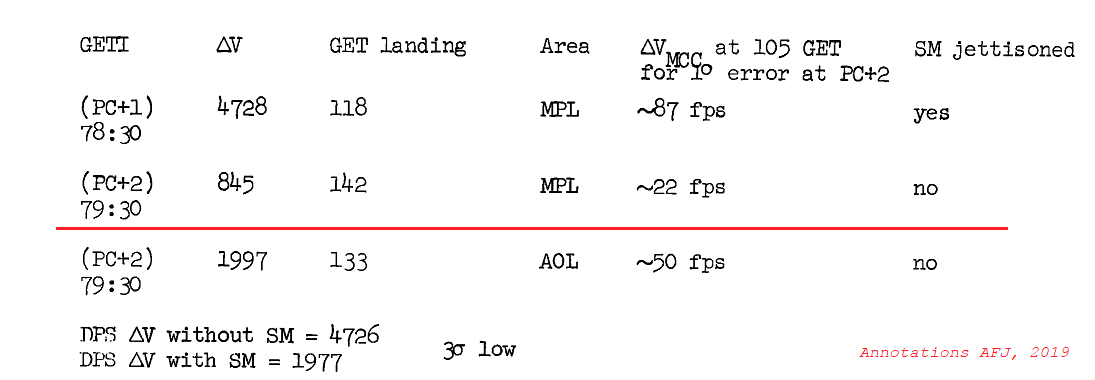
PC+2 burn options as calculated by Retro. Eventually selected mode underlined.
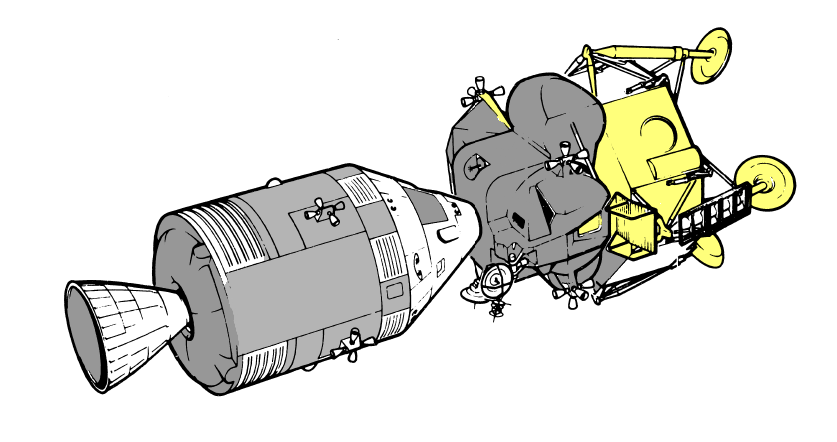
Apollo docked configuration.
063:09:03 Lousma: Okay, Fred. I have a correction in Noun 81. Delta-V
Z is minus 02226. Read back. [Pause.]
063:09:22 Haise: Okay. Delta-V
Z in Noun 81 is minus 02226.
063:09:28 Lousma: Okay. Good readback. [Pause.]
063:09:41 Haise: Somehow that didn't add up with the Delta-V
X to give a Delta-V
R of that magnitude. It seems like it'd been bigger.
063:09:52 Lousma: Okay. We'll take another look at it, Fred.
063:12:29 Lovell: Okay, Houston. I'm not having too much luck holding this particular attitude. [Pause.]
063:12:42 Lousma: Okay, Jim. Stand by one.
063:14:17 Lousma: Okay, Aquarius. When you get her pretty much in attitude there, and it looks like you're as close as we need to be, we'd like to try a control mode and see if it will work; sort of a semi-PTC. We'll leave the ball powered up for this, and if this doesn't work, why, we'll have to revert to Attitude Hold mode. But - Stand by one, please. [Long pause.]
063:15:03 Lousma: We'd like you to think about this control mode, Jim, and see if you think it might work from what you know right now. We're a little skeptical, but we'd like to put it to you. So, once you get in a pretty good attitude, monitor in Verb 16 Noun 20, go to PGNS Minimum Impulse, Verb 76, as we have, and set up a yaw rate - yaw rate to the right. Monitor the middle gimbal on R3 on the DSKY and see if she'll kind of stabilize out. If not, the only other suggestion we've got is to go to PGNS Attitude Hold. We'll keep the ball up until you make this evaluation.
063:15:45 Lovell: Okay, Houston. You cut out, say again.
063:15:51 Lousma: Okay. Where'd you lose me, Jim?
063:15:56 Lovell: I lost you when you said try the control mode; you're a little skeptical.
063:16:01 Lousma: Okay. From what you say, we have to be a little skeptical of this procedure, but we'd like to have you try it and have you evaluate it. You can monitor the middle gimbal on R3. Before we power down the ball, we want your evaluation. The next best choice is PGNS Attitude Hold. Over.
063:16:24 Lovell: Okay. I'll try it. [Long pause.]
063:16:53 Lovell: Okay. Go ahead with the control mode procedure. [Long pause.]
063:17:30 Lovell: Hello, Houston; Aquarius.
063:17:33 Lousma: Go ahead, Aquarius.
063:17:36 Lovell: Okay. I'm not [Garbled] you. I can monitor register 3. I can probably keep it out of [garbled] - going into gimbal lock.
063:17:49 Lousma: Roger. How are pitch and roll? [Long pause.]
This is Apollo Control.
063:18:40 Lovell: Okay. I think I can control the gimbal angles in 16 20 with the compressors the way they are, but I'll have to try Minimum Impulse - Just a minute. [Long pause.]
063:19:04 Swigert: Okay, Jack. I've a question - one more question about Odyssey.
063:19:08 Lousma: Go ahead.
063:19:14 Swigert: Okay, I still have the Pyro A sequence A and Pyro B sequence B circuit breakers in. Do you want those out?
063:19:23 Lousma: Stand by one. [Long pause.]
063:19:37 Lousma: Odyssey, Houston. The two circuit breakers you referred to, leave them in.
063:19:45 Swigert: Okay. Copy. Leave them in. [Long pause.]

Panel 250 in the Command Module.
063:19:59 Lovell: Okay, Houston. I can control yaw in minimum impulse, but stand by on pitch. [Long pause.]
063:20:17 Lousma: And, Freddo, the Delta-V
R resultant computes with the components.
063:20:29 Lovell: Fred's off the comm now, Jack.
063:20:32 Lousma: Roger. Your PAD is good.
063:20:35 Haise: And, Jack, we didn't get that whole sentence there.
063:20:39 Lousma: Okay. I said that the Delta-V
R that Fred questioned computes well with the component - its RMS.
063:20:49 Haise: Okay. Copy.
063:20:54 Lovell: Okay, now. Jack, let's go over this once more. You wanted me to try out control of the spacecraft in the Pulse mode. Is that correct?
063:21:03 Lousma: That's affirmative. Set up a yaw right rate and monitor the middle gimbal angle.
063:21:16 Lovell: Okay. I can do that. I'm not too sure whether I can control roll or pitch in pulse, but I can control yaw in pulse - yaw in pulse on the ball.
063:21:30 Lousma: Roger. And remember we're not going to have a ball there, so that we're going to be monitoring CDUs on the DSKY, and if we get it off, it will be pretty hard to figure out where to fly back to; and, well, in addition, have to control the Omnis while we're doing this.
063:21:52 Lovell: Roger. [Pause.]
063:22:06 Lovell: Without the ball, I still have use of the TTCA for control of the - angles.
063:22:12 Lousma: Affirmative. You'll have the TTCA for pitch and roll.
063:22:18 Lovell: Okay. I think I can do that without the ball, and if you just give me the TTCAs I think I can control the spacecraft using 16 20.
063:22:31 Lovell: I'm going to yaw right. [Long pause.]
063:22:49 Lovell: Okay, Jack. I am now - The Register 1 is in the Decrease mode. [Long pause.]
063:23:36 Lovell: And, Houston, do you see anything wrong with this spacecraft motion?
063:23:46 Lousma: We have a data drop on right now, Jim; we'll look at it as soon as it comes up.
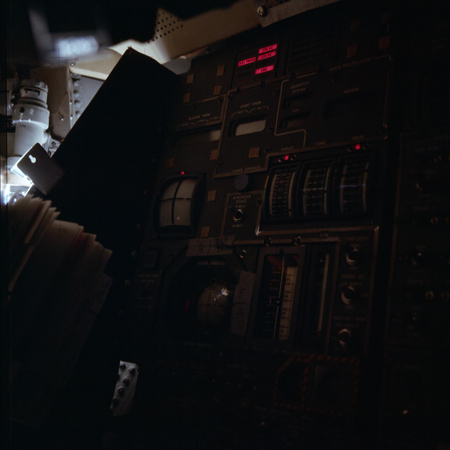
A view into the darkened LM cabin, with the taped direction marks visible. Color correction by David Woods.
063:24:52 Lousma: Okay, Aquarius. We're going to dispense with this control mode. We'd like you to fly the machine back to the original attitude that you had, and we'll go PGNS Attitude Hold, and then we've got to get that ball off the line to save some power. And then, in order to keep even heating, every 15 or 30 minutes, we'll give you a call to give us 90 or 180 degrees of roll - of yaw.
063:25:27 Lovell: Okay. You want me to go back to original attitude. I'll be going back to it now.
This is Apollo Control; 63 hours, 26 minutes Ground Elapsed Time. Recapping the upcoming pericynthion plus 2 hours maneuver with the Descent Propulsion System engine. Time of ignition: 79 hours, 27 minutes, 40 seconds. The velocity change will be posigrade 845.5 feet per second or a burn time of 4 minutes, 20 seconds. The throttle schedule on the Descent Propulsion engine will be 5 seconds at 10 percent, 21 seconds at 40 percent and the remainder of the 4 minutes and 20 seconds at full throttle. This burn will produce a splash in the southwest Pacific at 142 hours, 47 minutes Ground Elapsed Time. The tentative coordinates for entry interface, or 400,000 feet, is 28 degrees south latitude by 173 degrees, 14 minutes east longitude. Splashdown will be somewhat to the east of that, actually, across the international date line to about 173 degrees west longitude. The spacecraft presently 191,898 nautical miles [355,395 km] out from Earth; velocity, 3,034 feet per second [925 m/s]. And at 63 hours, 28 minutes Ground Elapsed Time; and standing by, this is Apollo Control.
063:28:36 Lovell: Okay, Houston; Aquarius. I'm flying it back over towards the initial angles you gave me of a pitch of 257. I'll get near the bellyband in roll and yaw; then I'll go to PGNS Att Hold.
063:28:47 Lousma: That's affirmative, Jim. And then we're going to have you go through a powerdown procedure.
063:29:02 Lousma: And you'll need Verb 77 with Att Hold when you get there.
063:29:08 Lovell: Will do.
063:31:48 Lovell: Okay, Jack. Have I gotten your 360 on yaw and roll? I'm going to go to Att Hold.
063:31:56 Lousma: Roger. And then we want to get the ball powered down.
063:32:02 Lovell: Okay. Stand by. [Long pause.]
063:32:52 Lovell: Okay. I'm now in PGNS Att Hold. And are you reading my DSKY angles?
063:32:58 Lousma: Roger. We see them.
063:33:03 Lovell: Now, you want me to power down the ball, and if you'll give me the procedure for that, I'll do it right away.
063:33:06 Lousma: Okay. We'll buy what you've got on the DSKY there, and we'd just like to go through an overall powerdown procedure, and in so doing we'll catch the ball and inverter and it will only take a few minutes. So are you ready to start on panel 11?
063:33:23 Lovell: Roger. Jack will copy, and I'll do the work.
063:33:27 Lousma: Okay. Panel 11, top row, open all the circuit breakers.
063:33:35 Lovell: All circuit breakers on top row coming open. [Pause.]
063:33:48 Lovell: They're all open, top row.
063:33:50 Lousma: Okay. Second row, close the first six on the left through the ISOL Valve and open all to the right of that.
063:34:07 Lovell: Okay. First six on the left are closed - That's through the ISOL Valve, but I opened up every one from there on.
063:34:13 Lousma: Okay. Third row, open up the next five - correction - Open up the first five on the left, close AOT Heater, close Sig[nal] Conditioner 1. Close Attitude Direct, and open the rest on row three.
063:34:46 Lovell: Do you want ATCA (PGNS) open?
063:34:53 Lousma: Leave ATCA (PGNS) closed; four breakers on the third row must be closed. AOT Heater, Sig Conditioner 1, and ATCA (PGNS), Attitude Direct Control. Our mistake, good going.
063:35:13 Lovell: Okay. I'm opening up Engine Start Override right now. And that row's taken care of.
063:35:30 Lousma: Okay. On the fourth row. Open - From the left, open the first five - correction - Close the first five, and open Cabin Fan 1. Close the three Glycol Pump circuit breakers; open all the Comm breakers, except for Commander's Audio; close it. All the PGNS breakers, open - correction - Open the first three PGNS breakers, close LGC/DSKY, IMU Standby, IMU Operate.
063:36:23 Lovell: That's complete, Jack.
063:36:27 Lousma: Okay. And EPS, close BAT Feed Ties, Cross Tie Bal Load, and open the Cross Tie Bus. Close the next three; open Ascent ECA Control, Ascent ECA, and Inverter 1. Close DC Bus Volt. Go ahead.
063:37:02 Lovell: That's complete, Jack. Panel 11 is configured.
063:37:09 Lousma: Okay. Let's go over to panel 16, top row, and starting from the left - Open the first four.
063:37:27 Lovell: Stand by, Jack. [Pause.]
063:37:38 Lovell: Okay. Starting from the left, open the first four.
063:37:43 Lousma: Okay. And close the Isol Valve, keep your TCA breakers closed, close the Crossfeed, open the next two displays. Close the Main SOV and the Propulsion breakers should all three be open.
063:38:08 Lovell: Roger. The main valves are closed, and the Display Engine Override Logic's coming open, and the PQGS and ASC He REG are open.
063:38:18 Lousma: That's affirmative. The second row: they should all be open except for three breakers under instrumentation. Close Sig Sensor, PCM/TE, and Sig Conditioner 2. Over.
063:38:41 Lovell: Roger. Do you want Suit Flow Control open? [Long pause.]
063:38:57 Lovell: Engine ARM coming open and ASA I guess will be open. Is that correct?
063:39:01 Lousma: We just got a change on that. Let's keep the ASA closed.
063:39:09 Lovell: How about Suit Flow Control and Engine ARM? [Pause.]
063:39:22 Lousma: Okay, Jim. Suit Flow Control can be open, and Engine Arm - Engine Arm open.
063:39:40 Lovell: Okay. Let's go to row 3.
063:39:44 Lousma: Okay. Row 3 under Comm. Open Displays, close SE Audio, open VHF A Transmitter and B Receiver, close the Primary S-Band circuit breakers, both of them. Open the S-Band Antenna, PMP closed, TV open, and all the rest of them open under ECS, except CO
2 Sensor, closed.
063:40:24 Lovell: Roger. [Pause.]
063:40:31 Lousma: Okay. Under row 4: under Heaters, your RCS Quad heaters should ... four of them ... be closed, open Displays, open S-Band Antenna, open Sequence Camera. Under EPS, open Displays, close DC Bus Volt, open Inverter 2, open Ascent ECA Control and Ascent ECA, close Descent ECA, Descent ECA Control, Translunar Bus Tie, close Cross Tie Bal Loads, open Cross Tie Bus, close Bat Feed Ties. Over.
063:41:29 Lovell: That's been completed, Jack. [Long pause.]
063:41:55 Lousma: Okay, Jim. And we've already got a change to what we just told you. Under ECS, close the Cabin Repress, and ensure that the ASA Breaker is closed under S and C.
063:42:16 Lovell: The ASA Breaker is closed, but I closed the Cabin Repress.
063:42:25 Lousma: Okay, Jim. Looks like what we have to do is - In order to maintain even heating, we just have to yaw the whole machine about 90 degrees per hour in increments. So we'll give you a call when it's time to yaw 90 degrees. [Long pause.]
063:43:04 Lovell: Okay. We have to yaw the machine as I understand it, Houston, and you'll give it to me in increments of 90 degrees.
063:43:11 Lousma: That's affirm.
063:44:16 Lousma: Okay, Jim. Your present configuration has the following features. We got the electrical Buses cross tied through the Bal Load circuit breakers, and we have Auto Cabin Repress. One thing we'd like to do right now is to give you an uplink, so immediately we have to, on panel 11, close the Updata Link circuit breaker. Go to P00 and Data. Over. [Pause.]
063:44:52 Lovell: Okay. We're going to P00 and Data. The circuit breaker is closed.
063:48:57 Lovell: Houston, Aquarius. Did you say that you had a new PAD for us to copy?
063:49:02 Lousma: Jim, I passed that newest PAD that we have to Fred about 30 minutes ago. That's our latest. It's PC plus 2, and it begins with Noun 33 of 79 hours 27 minutes and 40.13 seconds. You got that one?
063:49:25 Lovell: Okay. We've got that one. What kind of a Att Hold Mode do you want us to do? Do you want us to do Wide Dead band? I didn't [garbled] on the DAP.
063:49:40 Lousma: Jim, the dead band is good the way it is. It's 5 degrees, if you want to stay in it. And stay in the PGNS Att Hold mode.
063:49:49 Lovell: Okay. [Long pause.]
063:50:33 Lousma: Two things, Jim. We want you to know that there's some pretty big attitude errors in, so if you go to Auto, the computer is going to try to crank you around, and the other thing is don't drink water out of the LM. [Pause.]
063:50:54 Lovell: Okay. You might think about this. You know we lost our oxygen pressure in the Command Module. [Long pause.]
063:51:56 Lousma: Aquarius, we're finished with the uplink. The computer is yours, and you can open the Updata Link circuit breaker. [Long pause.]
063:52:18 Lovell: Okay. We've opened up the Updata Link, and we've gone Off of Data, and I've got 16 20 in the computer.
063:52:28 Lousma: Roger, Jim. I guess we're going to just kind of perk away here now.
063:52:37 Swigert: Okay, Jack. One more question about Odyssey here.
063:52:45 Lousma: Go ahead, Jack.
063:52:50 Swigert: Okay. How about the Service Module O
2 supply valve? Do you want that off?
063:53:01 Lousma: Affirmative. Service Module O
2 supply off, Jack.
063:53:06 Swigert: Okay. On the way. [Pause.]
063:53:17 Lousma: And, Jim, we see a Program Alarm in there. We think it's just got to do with pulling the Updata Link circuit breaker - Updata too fast.
063:53:30 Lovell: Roger. I don't see it. Should I reset? [Pause.]
063:53:40 Lousma: Go ahead and reset, Jim.
063:56:11 Lovell: Houston, Aquarius.
063:56:16 Lousma: Go ahead, Aquarius.
063:56:21 Lovell: One thought that might occur here is that if we have low descent water pressure, we might consider taking the PLSS water and fill it in reverse. If that works, you might look at a procedure for that.
063:56:34 Lousma: That's a good thought. Let us bounce that around a little. [Long pause.]
063:57:12 Lousma: Okay, Jim. That's a good thought, and we've looked at that, and it looks like that's feasible. So if and when we need to do that, we will. [Long pause.]
063:58:11 Lovell: And, something else, Jack. When it's time for me to make my 90-degree yaw, what I planned on doing was going to Noun 76 hold and just pulse and yaw several times until the yaw start and hope that pitch and roll stay within the limit.
063:58:37 Lousma: Roger. It sounds like a good plan and you can use your TTCA in MIN IMPULSE to take care of pitch and roll.
064:00:21 Lousma: Aquarius, Houston. We see Ascent O
2 tank number 2 building up again, so we'd like to use something out of it, so turn on ascent O
2 tank number 2 and turn off descent O
2.
064:00:39 Lovell: Roger. Opening up ascent O
2 tank number 2, and turning off descent.
064:03:01 Lousma: And, Aquarius, Houston. We're starting to think about CO
2 buildup up in the Command Module there so we've got a recommendation, and what we're recommending is that you take the commander's hoses in the LM and put a cap over the red return hose and then figure out a way to fasten those hoses so they blow up into the CSM by extending them up through the tunnel as far as possible. And we'll get some flow out the blue side, circulate up and around the Command Module and to keep the CO
2 level down.
064:03:43 Lovell: Roger. We're thinking of that too, and one problem is that the comm is connected securely to the hose, so we've got to get the comm cable off somehow to get that - So we'll still have comm down here in the LM and you have the hose up there.
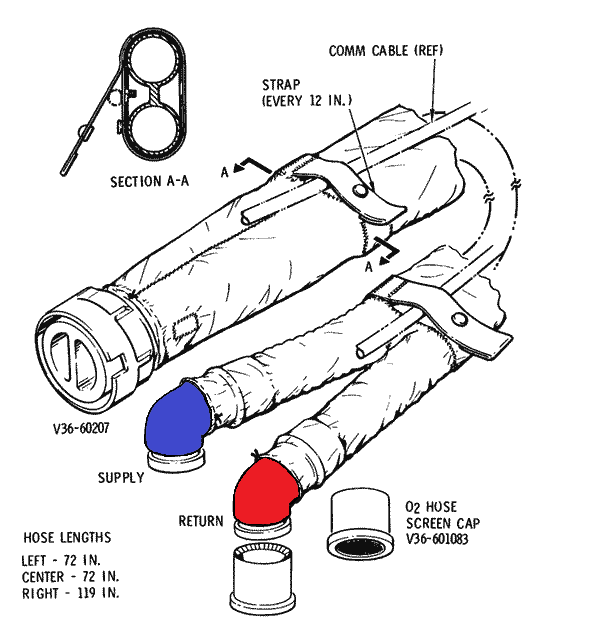
Arrangement of the O2 hoses and the comm cable.
064:05:10 Lovell: Houston, we're trying to extend that commander's hose by use of the vacuum hose.
064:05:22 Lousma: Sounds like a good plan if you can work that out, Jim.
064:06:58 Lousma: Aquarius, if you can shake Jack loose there, I've got a - some procedures for him to write down.
064:07:09 Lovell: Okay. Stand by. [Long pause.]
064:07:33 Swigert: Okay, Jack. Is this a long one?
064:07:37 Lousma: Oh, it's about 12 - 15 lines. It's a matter of verifying some valves and so forth. [Pause.]
064:07:50 Swigert: Okay. Go ahead.
064:07:53 Lousma: Okay. We want you to go in when you can and verify the following valves and leave them as we outline here. Repress Package valve, Off; Emergency Cabin Pressure, Off; Direct O
2, Off; Demand Reg, Off; both Water Accumulators, Off; Main REG A and B, Open; Water Glycol - correction - Water and then Glycol Tank Inlet and Outlet, both. Now if you want to get some water, we recommend that you momentarily turn the Surge Tank on to pressurize the system and then turn it off and take out water as required. Over. [Long pause.]
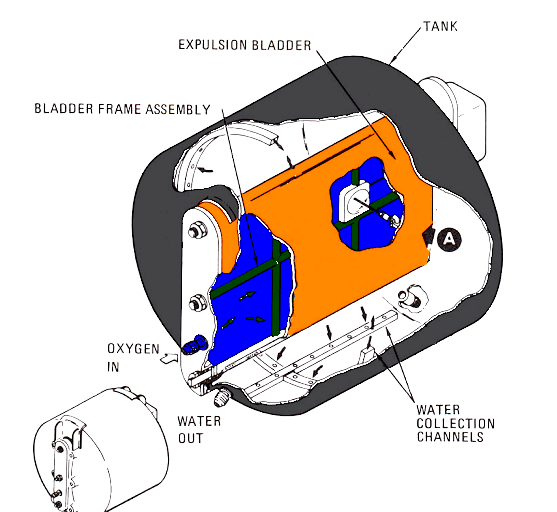
Diagram of the CM potable water tank.
064:09:33 Lousma: That's it, Jack. And another note on taking water; if you don't drain enough water so that...
064:09:43 Ground technician: [Garbled]
064:09:49 Lousma: Say again, Aquarius.
064:09:53 Swigert: That wasn't us, Jack.
064:09:58 Lousma: Okay. One more note on the water, Jack. If you don't bleed the pressure off when you - don't take enough water to bleed the pressure off completely, the pressure that's left on there is going to drain away in a period of 1 to 3 hours. So it's a small amount of oxygen, but we might as well save it. So if you want to eliminate that problem you could completely drain the pressure off by putting the water in a water bag and saving it that way. [Pause.]
064:10:36 Swigert: Okay. That's a good idea.
064:10:38 Lousma: So that's the end of my...
064:10:39 Swigert: What I'll do - let me repeat - Okay. Let me repeat it all back to you. Repress Package valve, Off; Emergency Cabin Pressure, Off; Direct O
2, Off; both the Demand Regs, Off; both H
2O Accumulators, Water Glycol Accumulators, Off; Main Reg A and B, Open; Water and Glycol Tank Inlet and Outlet, Open; for water, momentarily pressurize the Surge Tank, take out water as required. You're recommending drain out all the water until I can't get any more water out of it in order to conserve the oxygen.
064:11:34 Lousma: Okay. We just want you to turn off the water accumulators and not the glycol accumulator. Over.
064:11:49 Swigert: Okay. These are the water accumulators on 382, right?
064:11:57 Lousma: That's affirm. The accumulators on 382.




